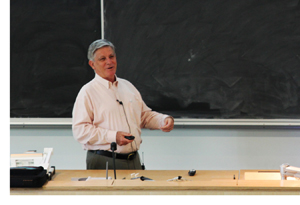PIMS Chats with Neil Trudinger
Back to the Root
 Neil Trudinger is an Australian mathematician who during his undergraduate degree was trying to decide between math and physics. “I had a job in a BHP laboratory working with engineers doing a lot of experimental stuff. I wasn’t good at that and sometimes the experiments had to be aborted because of some clumsy thing I had done. At the end of it, the supervisor said to me that if I was trying to decide between physics and math, ‘please don’t do physics!’” Hearing this made up Trudinger’s mind, and he decided to major in both pure and applied mathematics, specializing in applied.
Neil Trudinger is an Australian mathematician who during his undergraduate degree was trying to decide between math and physics. “I had a job in a BHP laboratory working with engineers doing a lot of experimental stuff. I wasn’t good at that and sometimes the experiments had to be aborted because of some clumsy thing I had done. At the end of it, the supervisor said to me that if I was trying to decide between physics and math, ‘please don’t do physics!’” Hearing this made up Trudinger’s mind, and he decided to major in both pure and applied mathematics, specializing in applied.
After completing a masters and PhD – on Quasilinear Elliptic Partial Differential Equations in n Variables – at Stanford University, Trudinger became an instructor at the Courant Institute of Mathematical Sciences of New York University. It could have been a great springboard for a career in mathematics, he admits, but he was adamant that he wanted to go back to Australia. “I understood that the link to the mathematical world would be much harder, but I went back and got interested in teaching and research.”
In 1977 Trudinger published a book with coauthor David Gilbarg entitled Elliptic Partial Differential Equations of Second Order. This book, and its subsequent editions (in 1983 and 1998), helped to make Trudinger one of the most cited mathematicians on MathSciNet and the book itself became the most cited publication. “Any success is always a bit of a surprise,” he says. “We took a classical area that was sort of “dying” and aimed to create a clean and complete account of it… We were very meticulous and careful with the language, reading it out aloud to get the words correct. We would argue often, as he was American and I Australian, over the proper spelling of words. Looking back, I realise that I could never write as well as that again.”
Following publication, the book’s subject area blossomed again, and Trudinger’s book provided an excellent introduction to it. “It was picked up in China after the Cultural Revolution and translated in order to help them catch up with western science. I found when I was there in 1985 that I was a very well-known name.” He attributes the book’s success to having assembled the content in a new way and the very careful consideration they took in its language and assembly.
From 1973-9 Trudinger served at the Australian National University (ANU) as Head of the Department of Pure Mathematics and in 1981 was honoured by the Australian Mathematical Society when he became the first recipient of their Australian Mathematical Society Medal. From 1982-90 he served as Director of the Centre for Mathematical Analysis at ANU, and returned as Director of the Centre for Mathematics and its Applications in 1991. In 1992 he became Dean of the School of Mathematical Sciences. Trudinger was elected a fellow of the Australian Academy of Science in 1978 and was awarded their Hannan Medal in 1996. He was also honoured with election as a fellow of the Royal Society of London in 1997.
Trudinger is currently working on optimal transportation and other areas related to geometry. In this vein, he and his colleague, Xu-jia Wang, found a new proof of the Monge problem, the defining problem in optimal transportation. The solutions to this problem satisfy complex partial differential equations of the Monge-Ampere type, one of his areas of focus. “We found out later that there was a flaw in the old proof, so in some sense we had ‘the proof’” he explains. “At the same time McCann, Feldman and Caffarelli, found a similar proof. In a way, these became the first complete proofs of the Monge problem in general dimension.”
As someone who has been very successful in mathematics, Trudinger offers some advice for those starting out, “Concentrate on the mathematics and the fundamental achievement of discovery. Don’t just follow the experts, because you’ll rarely overtake them; try to find your own niche. Make your own path in mathematics.”